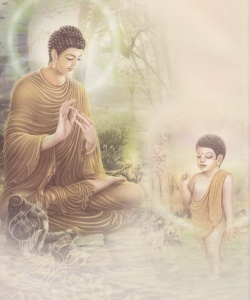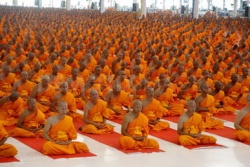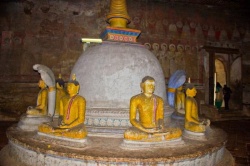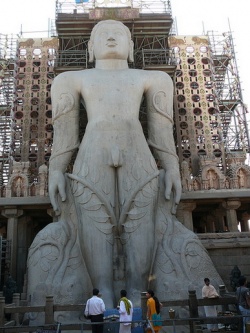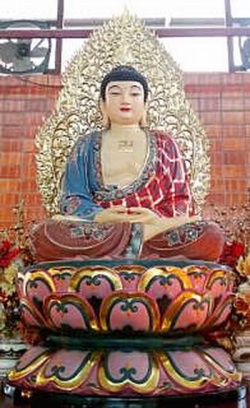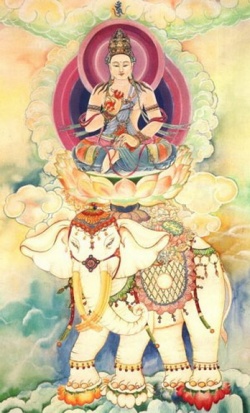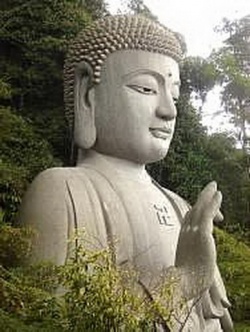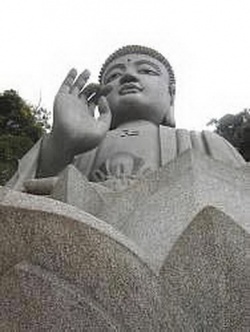Buddhism In Pre-Islamic Times
Origin and early spread of Buddhism. Buddhism arose in northeast India in the sixth century b.c. as the result of the teaching of the historical Buddha Śākyamuni, who died about 483 b.c.
Origin and early spread of Buddhism. Buddhism arose in northeast India in the sixth century b.c. as the result of the teaching of the historical Buddha Śākyamuni, who died about 483 b.c. During the years after his death his followers were active in establishing the canonical scriptures and the religious rules for daily life among Buddhist communities. Unanimity was never attained, and the Buddhist community divided into increasingly more numerous sects. That Buddhism did not remain a minor sect despite these internal dissensions may be due largely to the patronage extended to the religion by the famous Indian emperor Aśoka, who acceded to the throne in about 268 b.c. After his conquest of Kalinga (Orissa) in about 260 b.c., he was so affected by the massacre that occurred that he resolved thereafter to refrain from violence, and he took the vows of a lay Buddhist.
Much is known of Aśoka’s reign from his own inscriptions, which have been found in widely distant parts of his kingdom (See aśoka ii). Most famous are the so-called Rock Edicts and Pillar Edicts. The inscriptions are of varied content, but consistently promulgate the ethical standards of Buddhist teaching that he wished to inculcate. They are mostly inscribed in the local Prākrits; using Brāhmī script, although in the northwest the Kharoṣṭhī script, derived from Aramaic writing, was used for two of his edicts. The Aramaic language itself was used for several inscriptions from the northwest (See aramaic i-ii). One of these, discovered only in 1958, was the remarkable bilingual inscription from Qandahār in Afghanistan. Its two languages are Greek and Aramaic. The use of Aramaic and of the Kharoṣṭhī script indicates Iranian influence, and even the two rock edicts written in Prākrit in Kharoṣṭhī script at Ṣāhbāzgaṛhī and Mānsehrā contain Iranian loanwords. It is in this border region including Iranian territory under Greek control and Indian territory, where Indians, Greeks, and Iranians lived side by side, that we see the first indications that Buddhism was to be adopted by non-Indian peoples.
In 1963 a long inscription entirely in Greek was found in Qandahār. It was subsequently identified as a translation of parts of two of Aśoka’s edicts and thus bears testimony to the missionary activity supported by Aśoka. Further visible testimony is provided by the remains of his considerable building activity. By popular legend he was credited with the erection of 84,000 stūpas. The stūpas of the time of Aśoka and his immediate successors were markedly distinct in style from those built later under the Kushans. This difference had already been noticed by the famous 7th-century Chinese pilgrim Hsüan-tsang, who observed a large number of stūpas in the Aśokan style in the northwest, e.g., three at Takṣáhilā (Taxila), two in Uḍḍiyāna, five in Gandhāra, three near Nagarahāra (Jalālābād), dozens in Jāguḍa (near Qandahār), and even one at Kāpiśī (Begram).
Introduction of Buddhism into Bactria. Exactly when Buddhism became established in Bactria is still much disputed. Some scholars argue in favor of the first century b.c., or even earlier, while others maintain that its spread was due to the Kushans (Staviskij, pp. 201ff.). Kushan influence certainly extended well into China in the first centuries a.d. This is clearly shown by, among other things, the use of the northwest Prākrit written in the Kharoṣṭhī script as the language of administration in the kingdom of Shan-shan, a short distance east of Khotan. These documents have been dated to between a.d. 200 and a.d. 320 (see Brough, esp. pp. 594-604). A Kharoṣṭhī well inscription dating probably from the second half of the second century a.d. was found at Loyang in China (Brough). Even in the early years of the third century there were at least two monasteries in Loyang, and many foreign translators were active in Loyang in the second half of the second century (Zürcher, 1959, pp. 30ff.). By about a.d. 400 Fahsien estimated that there were more than 4,000 monks in Shan-shan (Beal, I, p. xxiv).
Introduction of Buddhism into Chinese Turkestan. It is similarly uncertain at what date Buddhism penetrated into Chinese Turkestan. Late traditions associated the foundation of Khotan with the son and minister of Aśoka (see aśoka iv). According to these accounts the foundation of Khotan was effected by a compromise between exiled groups of Indians on the one hand and of Chinese on the other. These accounts have been dismissed by many scholars as merely eponymous legends. However, several considerations seem to lend them credence. Certainly in the first century b.c., when our first records of the history of Khotan begin, in the Early Han Annals, Khotan was clearly divided in two halves, no doubt the Indian and Chinese colonies respectively. Moreover, from Yotqan, the ancient site of Khotan, we have a collection of coins from the first centuries a.d. bearing Chinese legends on the obverse and Indian Prākrit ones in Kharoṣṭhī script on the reverse (Stein, pp. 204-05, 575-76; Hoernle, pp. 1-16; Thomas; Cribb). If it had been the aim of the authors of these accounts to assign as early a date as possible for the arrival of Buddhism in Khotan, they would have attributed its introduction to the Aśokan period, but the tradition handed down in Tibetan explicitly states that Buddhism was introduced 165 years after the origin of Khotan, that is about 84 b.c. (Emmerick, 1967, p. 23). It is generally considered that even that date is rather early for Buddhism to have been established in Khotan (Daffinà, pp. 187-91), but it is not entirely impossible (Zürcher, 1959, p. 23).
Buddhism under the Kushans. The Kushans, a people of uncertain ethnic extraction but speaking the Iranian Bactrian language, controlled the famous caravan route that proceeded from Taxila via Bāmīān to Balḵ and thence to Termez on the Afghan border. It was no doubt by this route that Buddhism reached central Asia and Chinese Turkestan and maintained contact with India. All along the route and to the east of it there have been found archeological remains of Kushan Buddhist occupation. To the Kushan period dates the most famous example of Buddhist rock-hewn architecture among Iranians, the colossal rock-hewn Buddhas, 35 and 53 m tall, at Bāmīān in Afghanistan. They greatly impressed Hsüan-tsang in the seventh century (Beal, I, pp. 49-53) but seem to have been first mentioned in the west by Thomas Hyde in a.d. 1700 (Hyde, p. 132).
Buddhist stūpas at Kushan sites include those at Wardak, thirty miles west of Kabul, those around Kāpiśī (Begram), the Haḍḍa and Bīmarān stūpas in the Jalālābād district, ancient Nagarahāra, and the Tepe Rostam outside Balḵ. On the Soviet side of the Afghan border are the sites of Termez (Dharmamitra) and nearby Airtam, where Russian expeditions have found Buddhist remains of the Kushan period. The most interesting are the Airtam frieze and the cave monastery at Qara Tepe. The huge Buddhist monastery at Qara Tepe in the northwest corner of Termez is thought to have been founded at about the beginning of the second century a.d. (Frumkin, p. 111; Litvinsky, p. 21).
Sorḵ Kotal. East of the main caravan route is the renowned site of Sorḵ Kotal (Surkh Kotal), the ancient Baḡlān mentioned by Hsüan-tsang (Beal, I, p. 43). It was here that the first major Kushan inscription was found written in the Northeast Iranian language that is nowadays called Bactrian. The inscription concerns the restoration of the sanctuary founded there by Kanishka, the famous Kushan ruler, under whose patronage Buddhism flourished. The site seems to have no Buddhist connections, but like Buddhist sites elsewhere it seems to have suffered from the attacks of the Sasanians in the 3rd century. It may have been the site of a dynastic cult or of an unusual Buddhist sect.
Nowbahār. It has been suggested that the term “Nowbahār,” a Persian form of Sanskrit nava-vihāra “new temple,” may designate the sites of a specifically Iranian Buddhist sect (Bulliet; see also ii, below). The most famous Nowbahār was at Balḵ, but the name is attested as far north as Bukhara and Samarkand and as far west as beyond Hamadān. As long as it is not known exactly what significance the term had, it would be inadvisable to conclude from its attestation alone that the sites associated with it were important centers or Buddhism.
Buddhism in Chorasmia and Sogdiana. Kushan influence is known to have spread northward into Chorasmia and Sogdiana, but it seems doubtful whether these regions were ever under Kushan rule, and there is not much evidence of Buddhism in these regions in the Kushan period. The fact that some of the early translators of Buddhist scriptures into Chinese were of Sogdian origin, such as Kʿang (= Samarkand) Meng Hsiang, who worked at Lo-yang from a.d. 194-99 (Zürcher, 1959, p. 23), can hardly be regarded as evidence for the early establishment of Buddhism in Sogdiana. Nor has archeology brought to light any early Buddhist monuments north of the Oxus region (Termez, Airtam, etc.). The sites excavated at Varakhsha (near Bukhara), Afrāsīāb, and Panjikent (near Samarkand) are conspicuously non-Buddhist, while the Buddhist sites further east at Ajina Tepe near Kurgan-Tyube, at Kuva in Farḡāna, and at Ak-Beshim near Frunze all belong to the 7th or 8th centuries. Even at this date Buddhism cannot have been of much importance around the capital, as the sites near Bukhara and Samarkand show clearly enough. Hsüan-tsang in the 7th century found little Buddhist following in Samarkand (Beal, 1911, p. 45; Litvinsky, p. 42), and despite his claim to conversions there, when the Korean pilgrim Huei-cḥʿao visited Samarkand early in the 8th century, he found only a solitary Buddhist monastery with a solitary monk (Fuchs, p. 452). Everywhere Zoroastrianism was practiced. Moreover, there is hardly a trace of Buddhism in the 8th-century Sogdian documents from Mt. Mugh.
Buddhism in western Iran. As for the westward extension of Buddhism it is still not clear how far to the west Buddhism penetrated. On the basis of archeology it had been inferred that it never flourished west of the line joining Balḵ to Qandahār, the so-called “Foucher line,” named after the famous French archeologist (Foucher, I, pp. 155-57; II, pp. 281-82). After Zoroastrianism had become the official religion of the Sasanians in a.d. 224, other religions, including šamans and brahmans (i.e., Buddhists and Hindus) were not tolerated, as we know from the inscriptions of the priest Kartīr (Back, p. 415). Consequently it is only to be expected that the main expansion of Buddhism should have been eastward rather than westward. Nevertheless, the Russian discovery of a Buddhist stūpa at Gyaur Kala near Bagram-ʿAlī more than 400 km west of Balḵ in the Marv oasis was thought to have disproved the Foucher hypothesis (Koshelenko). However, even if there were isolated instances of Buddhist communities farther west, the main thesis that Buddhism flourished predominantly in the east seems unassailable. Even in the case of Gyaur Kala, it appears that the building of the stūpa was interrupted in the 3rd century and that it was destroyed in the 5th (Litvinsky, p. 29).
The Iranian contribution to Buddhism. It is no longer possible to determine what the specifically Iranian contributions to Buddhism may have been. That Buddhism should have passed through Iranian territory to Chinese Turkestan without being affected by Iranian influence seems highly improbable. In particular, the spread of Buddhism under the Kushans coincides with dramatic developments in Buddhist doctrine, art, and literature, developments that are characteristic of northern Buddhism exclusively, and in which Bactrians, Sakas, and Parthians must certainly have participated.
Among these developments are the rise of the Mahāyāna school of Buddhism and the style of Buddhist art known as “Gandharan.” These developments were no doubt closely connected with each other and may have arisen as a result of the contact between Greek, Iranian, and Indian influences in the northwest. In Mahāyāna Buddhism the historical Buddha Śākyamuni is regarded as only one of many Buddhas and hence less as an almost unattainable ideal. Characteristic of Gandharan art is the representation of the Buddha in human form. The increasing prominence of the layman in Mahāyāna is reflected in the common portrayal of laymen in art. Probably not without significance is the fact that one of the most commonly depicted episodes in the Kushan period is the giving of food to the Buddha by the two merchant brothers Trapusa and Bhallika. They were depicted in Indo-Scythian dress and bearded in a 2nd-century relief at Shotorak (Meunié, pp. 45-46; Rosenfield, pp. 220-22). Bhallika was early associated with Balḵ.
The cult of the Bodhisattva is also reflected in Gandharan art. The ideal of the Bodhisattva in the Mahāyāna supplanted the ideal of the Arhat. The most famous of the Bodhisattvas commonly represented in the Kushan period is the future Buddha Maitreya. His rise to prominence has often been associated with the contemporary belief in the Messiah among the Jews and the soteriology of the Zoroastrian future savior Saošyant (q.v.; Rosenfield, pp. 227ff.). In the Mahāyānist conception of the Bodhisattvas Amitābha and Avalokiteśvara, who subsequently became enormously popular in the east, the influence of the Iranian Zurvān and Miθra has been detected (de Mallmann, pp. 85-95). Such matters necessarily remain highly speculative, and it is not possible to do more than point out some of the spheres where Iranian influence is likely to have played a part.
Iranians played an important part in the transmission of Buddhism to the east. Among the early translators of Buddhist texts into Chinese were Parthians, Sogdians, and Khotanese. (The earliest known of these translators was An Shih-kao, a Parthian; q.v.). But although these Iranians no doubt had contact with the west and were acquainted with Iranian cultural traditions, it was in Chinese Turkestan that they were active, and it is likely that much of the influence of Iranians on Buddhist thought and culture was actually exerted in Chinese Turkestan. There are grounds for thinking that there was a mutual exchange of ideas between Iranian Buddhists in eastern Iran and those further to the north and east.
Buddhism and Manicheism. The founder of the Manichean religion, Mānī (a.d. 215-74), spent a year in the northwest of India, where he would have had contact with Buddhism (cf. Sundermann, pp. 87-90). But the introduction of Indian Buddhist terms into some of the Manichean Parthian texts makes it likely that they were composed in one of the centers where Manicheism and Buddhism flourished side by side (Sims-Williams). Such a center, indeed the most notable center, was Balḵ from the 3rd to the 8th century. The Sogdian Manichean texts on the other hand all come from the Turfan region in Chinese Turkestan, whither the Manicheans had fled from the Arabs. In this region also Manicheism coexisted with Zoroastrianism, Christianity, and Buddhism (cf. Lieu, esp. chaps. VII-VIII).
Buddhism in Chinese Turkestan. At the beginning of the Christian era the main towns along the northern route across Chinese Turkestan, Kučā, Qarāšahr (earlier Yen-cḥʿi), and the towns of the Turfan region, were mainly occupied by people who spoke the so-called Tocharian language. But Chinese influence in the Turfan region goes back to the first century b.c., when they founded Kao-cḥʿang (Qočō), which was the chief city of the Turfan region during most of its history (Pelliot, 1959, pp. 162ff.). Buddhism came early to all these regions, and Kucheans were among the early translators of Buddhist texts into Chinese (Zürcher, 1959, pp. 68-69,103, 226). Sogdians of Buddhist, Manichean, and Christian beliefs lived in Qočō from about the 5th to the 9th century.
The Buddhist texts written in the Sogdian language come from the Turfan and Tunhuang regions of Chinese Turkestan. They are almost all Mahāyānist texts translated from Chinese and are on the whole rather inaccurate translations made by Sogdians who used Chinese as the language of trade. The Sogdians evidently acquired Buddhism from the Chinese.
According to the testimony of Huei-cḥʿao, in Kučā the local population followed the Hīnayāna school of Buddhism, as is borne out by the texts surviving in the Kuchean (Tocharian) language, while the Chinese community practiced the Mahāyāna (Fuchs, p. 456). We have a solitary case of a fragment of a translation of an unidentified Buddhist text from Kuchean into Sogdian (Henning, pp. 59-62). The Kuchean translations of the same period were made from Indian originals.
It was among another Iranian people, the Sakas, that Buddhism found its most enthusiastic reception. They formed the ruling class in Khotan, the chief kingdom of southern Chinese Turkestan during much of its history. There was a Buddhist community in Khotan by the 2nd century according to Chinese sources, and as early as the middle of the 3rd century we hear of a Chinese Buddhist pilgrim going to Khotan (Beal, I, p. x). It was a major center of Buddhist studies when Fa-hsien visited it about a.d. 400 on his way to India, and it had expanded still further when Hsüan-tsang spent some months there in the 7th century on his way back from India to China. Both pilgrims noted the very large number of monasteries in Khotan (Beal, I, pp. xxv-xxvii, II, p. 309). So too did the Korean Huei-cḥʿao in the 8th century (Fuchs, p. 456). That Buddhism flourished there in the 9th and 10th centuries we know from Khotanese sources.
The influence of Khotan was certainly considerable. A Tibetan text records how the king of Khotan converted the king of Kashgar to Buddhism (Emmerick, 1967, pp. 45ff.), but the Hīnayāna was mainly followed there, which suggests that its subsequent links were rather with the cities of the north. Such was the case also with Tumshuq, whose Buddhist monastery is thought to date from the 4th or 5th century a.d. (Hambis, 1964, p. 43; Pelliot, 1923, p. 59). We know nothing of its history, but the style of its artistic remains shows strong links with Qızıl in the Kučā region. That it was inhabited by Saka monks is shown by the find of a manuscript containing the ceremonial formulae for the dedication of laywomen (Emmerick, 1985), written in Tumshuqese, an Iranian language closely related to Khotanese.
It is not possible to assess the part played by Khotan in the development of the Mahāyāna, but its role is likely to have been of considerable importance. The Khotanese did not confine themselves to translating Indian Buddhist texts into their native tongue, although an impressive array of Mahāyānist texts in Khotanese translation survives in part or in full, but there were also original works composed in the Khotanese language itself (cf. Emmerick, 1979). Of these the best known and the most popular was the book that the official Zambasta ordered to be written (see book of zambasta), a compendium of Buddhism in verse form. In the second half of the 10th century original Tantric texts were being composed in Khotanese. It is likely that earlier original works would usually have been written in Sanskrit, which was regarded in Khotan as the sacred language of Buddhism. (See also iii, below.)
The demise of Buddhism among Iranian peoples. Buddhism was flourishing more in Khotan than in India by the 10th century, from which period most of the surviving Khotanese literature comes. But it is not likely to have persisted long after the Muslim invasion at the beginning of the 11th century, when the capital at Yotqan, near the modern city of Ho-tien, was abandoned (Barthold, Turkestan2, p. 281; Grenard, pp. 5-79; Samolin, pp. 80-82). According to Marco Polo, who visited Khotan in the 13th century, all the inhabitants were Muslims (Yule, I, p. 188).
Buddhism seems to have survived longest in Qočō, an early haven of Buddhism, where it continued long after it had disappeared from most of Chinese and western Turkestan. Even in a.d. 1420 there were reportedly Buddhists and great temples in Qočō (Pelliot, 1959, p. 164).
In the west Buddhism suffered a serious setback at the hands of the Sasanians during the 3rd century, but although the Buddhists were persecuted and many of their sanctuaries were burned, they survived to a much later period. At such places as Bāmīān they were still active as late as the 8th or 9th centuries (cf. Marquart, Ērānšahr, p. 292; Melikian-Chirvani, pp. 21ff.). Nevertheless, although Buddhism persisted for some time after the rise of Islam and the Arab invasions from the 7th century onward, when the rulers of Bāmīān gave their allegiance to Islam in the latter part of the eighth century, the end of Buddhism in this area was in sight.
Bibliography:
M. Back, Die sassanidischen Staatsinschriften, Acta Iranica 18, Tehran and Liège, 1978.
S. Beal, Si-yu-ki. Buddhist Records of the Western World, 2 vols. in one, London, n.d.
Idem, tr., The Life of Hiuen-Tsiang by the Shaman Hwi Li, London, 1911, repr. New Delhi, 1973.
A. Belenitsky, Central Asia, tr. J. Hogarth, London, 1969.
J. Brough, “A Kharoṣṭhī Inscription from China,” BSOAS 24, 1961, pp. 517-30.
Idem, “Comments on Third-Century Shan-Shan and the History of Buddhism,” BSOAS 28, 1965, pp. 582-612.
R. W. Bulliet, “Naw Bahār and the Survival of Iranian Buddhism,” Iran 14, 1976, pp. 140-45.
M. Bussagli, “Afghanistan,” in Encyclopaedia of World Art I, New York, 1959, cols. 32-47.
J. Cribb, “The Sino-Kharoṣṭhī Coins of Khotan,” pt. 1, NC 144, 1984, pp. 125-52; pt. 2, NC 145, 1985, pp. 136-49.
P. Daffinà, “Sulla più antica diffusione del buddismo nella Serindia e nell’Iran orientale,” in Monumentum H. S. Nyberg I, Acta Iranica 4, Liège and Tehran, 1975, pp. 179-92.
R. E. Emmerick, Tibetan Texts Concerning Khotan, London, 1967. Idem, A Guide to the Literature of Khotan, Tokyo, 1979.
Idem, The Tumshuqese Karmavācana Text, Mainz, 1985.
A. Foucher, La vieille route de l’Inde de Bactres à Taxila, 2 vols., Paris, 1942, 1947.
G. Frumkin, Archaeology in Soviet Central Asia, Leiden and Cologne, 1970.
W. Fuchs, “Huei-cḥʿaos Pilgerreise durch Nordwest-Indien und Zentral-Asien um 726,” SPAW, phil.-hist. Kl., Berlin, 1938, pp. 426-69.
A. von Gabain, “Der Buddhismus in Zentralasien,” in HO I/VIII, 2, Leiden, 1961, pp. 496-514.
S. Gaulier, R. Jera-Bezard, and M. Maillard, Buddhism in Afghanistan and Central Asia, 2 pts., Leiden, 1976.
F. Grenard, “La légende de Satok Boghra Khân et l’histoire,” JA 15, 1900, pp. 5-79.
L. Hambis, “Asia: Central,” in Encyclopaedia of World Art I, cols. 815-38.
Idem, Toumchouq II, Paris, 1964.
G. Hambly, ed., Zentralasien, Fischer Weltgeschichte 16, Frankfurt am Main, 1966.
H. W. Haussig, Die Geschichte Zentralasiens und der Seidenstrasse in vorislamischer Zeit, Darmstadt, 1983 (esp. pt. II). W. B. Henning, Sogdica, London, 1940.
A. F. R. Hoernle, Report on the British Collection of Antiquities from Central Asia I, JASB 68, Suppl. 1, 1899.
T. Hyde, Historia Religionis Veterum Persarum, Eorumque Magorum, Oxford, 1700.
G. Koshelenko, “The Beginning of Buddhism in Margiana,” Acta Antiqua Academiae Scientiarum Hungaricae 14, 1966, pp. 175-83.
E. Lamotte, “Sur la formation du Mahāyāna,” in Asiatica. Festschrift Friedrich Weller, Leipzig, 1954, pp. 377-96.
Idem, Histoire du bouddhisme indien des origines à l’ère Saka, Louvain, 1958.
S. N. C. Lieu, Manichaeism in the Later Roman Empire and Medieval China. A Historical Study, Manchester, 1985. B. A. Litvinsky, Outline of Buddhism in Central Asia, Moscow, 1968.
B. A. Litvinskiĭ and T. I. Tseĭmal’, Adzhina Tepa, Moscow, 1971.
G. P. Malalasekera, ed., Encyclopaedia of Buddhism, Ceylon, 1961-.
M.-T. de Mallmann, Introduction à l’étude d’Avalokiteçvara, Paris, 1967.
A. S. Melikian-Chirvani, “L’évocation littéraire du bouddhisme dans l’Iran musulman,” Le monde iranien et l’Islam 2, 1974, pp. 1-72 (reviewed by G. Fussmann, JA, 264, 1976, pp. 197-200).
G. Meunié, Shotorak, MDAFA 10, Paris, 1942.
P. Pelliot, review of A. von Le Coq, Die buddhistische Spätantike in Mittel Asien, pt. 1, Berlin, 1922, in T’oung pao 22, 1923, pp. 57-59.
Idem, Notes on Marco Polo, Paris, 1959.
J. M. Rosenfield, The Dynastic Arts of the Kushans, Berkeley and Los Angeles, 1967.
W. Samolin, East Turkestan to the Twelfth Century, The Hague, 1964, pp. 80-82.
N. Sims-Williams, “Indian Elements in Parthian and Sogdian,” in Sprachen des Buddhismus in Zentralasien, ed. K. Röhrborn and W. Veenker, Wiesbaden, 1983, pp. 132-41.
B. Ja. Staviskij, La Bactriane sous les Kushans. Problèmes d’histoire et de culture, rev., ed., and tr. by P. Bernard et al., Paris, 1986.
B. Y. Stavisky and G. M. Bongard-Levin, eds., Central Asia in the Kushan Period, 2 vols., Moscow, 1968.
M. A. Stein, Ancient Khotan, Oxford, 1907.
Shinsho Hanayama Bibliography on Buddhism, Tokyo, 1961.
W. Sundermann, “Zur frühen missionarischen Wirksamkeit Manis,” Acta Orientalia Hungarica 24, 1971, pp. 79-125.
F. W. Thomas, “Sino-Kharoṣṭhī Coins,” NC 4, 1944, pp. 83-98.
H. Yule, The Book of Ser Marco Polo, the Venetian, Concerning the Kingdoms and Marvels of the East, tr. and ed., with notes, 2 vols., London, 1903.
E. Zürcher, The Buddhist Conquest of China, Leiden, 1959; repr. 1972.
Idem, Buddhism. Its Origin and Spread in Words, Maps and Pictures, London, 1962.
(Ronald E. Emmerick)
This article is available in print.
Vol. IV, Fasc. 5, pp. 492-496

